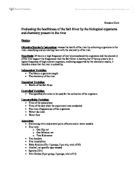River Thame Investigation How does the distribution of mayfly larvae depend upon the rate of flow of the river
Example 8
River Thame Investigation
How does the distribution of mayfly larvae depend upon the rate of flow of the river
Thame
Planning – I had help from two of the field centre staff who helped me choose the factors and showed me how the probe worked.
Aim: To see if there is a relationship between the numbers of macro invertebrates, looking at mayfly larvae, and the speed of the stream.
Prediction: There will be more mayfly larvae when the speed of the stream increases.
Background: The field centre staff, Bob and Eileen, gave a talk to the class about the different types of organisms found in the stream. They mentioned the macro invertebrates and how many of them are adapted to hold onto the rocks in the stream to avoid being swept away. They then hunt for prey by crawling along the river bed or hang off the rocks and capture meals as they fly by. I also think that they will be less in the slower water as it will be easier for the predators of the macro invertebrates to find them when they are in the slow water.
Variables:
Independent – speed of the stream
Dependent – number of mayfly larvae
Controlled – number of times data collected at each site, how the samples are collected – kick sample and speed probe, transect across the stream at three places, data collected on the same day – similar weather conditions.
Method
Materials: Speed probe from field centre, macro invertebrate net, Wellington boots, meter ruler, string, temperature probe
The stream was sampled at the place it enters the field centre, where there is a meander and as it leaves the field centre – just after a weir.
At each site a string was placed across the stream and the macro invertebrates, the temperature, the speed and the depth were sampled.
At each point one kick sample was done, the macro invertebrates were released back into the stream after each site was completed. Three samples of temperature and speed were taken at each point and one depth.








